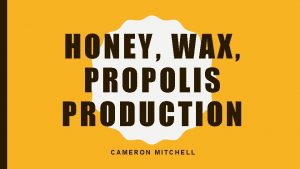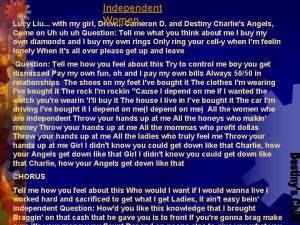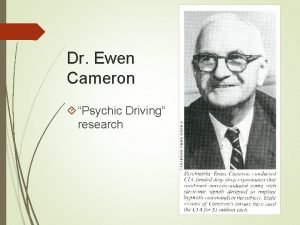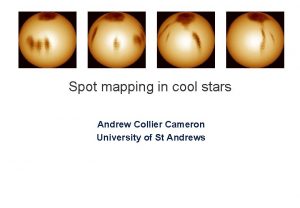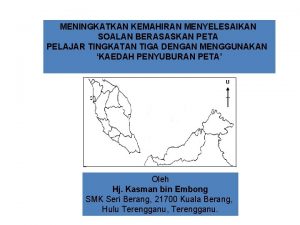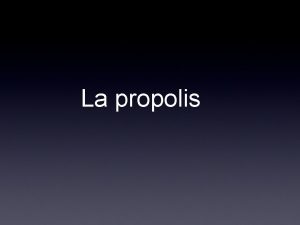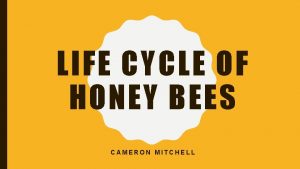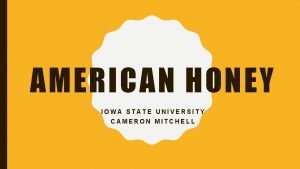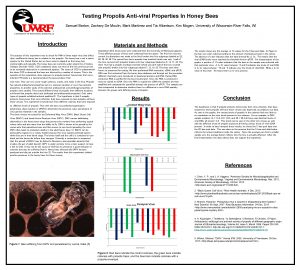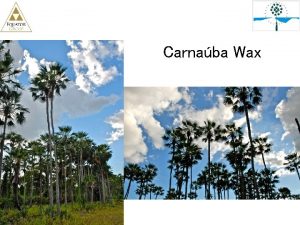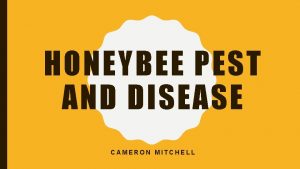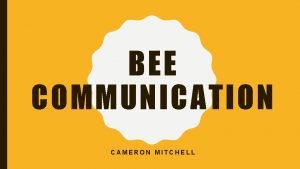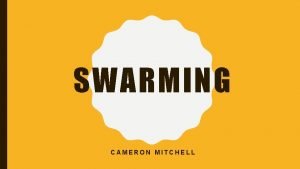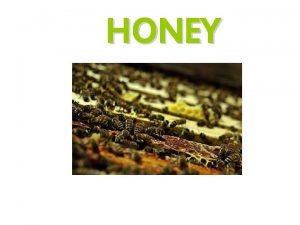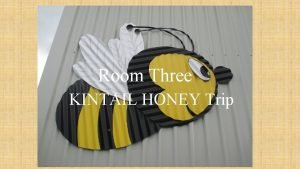HONEY WAX PROPOLIS PRODUCTION CAMERON MITCHELL STUDENT LEARNING






































- Slides: 38

HONEY, WAX, PROPOLIS PRODUCTION CAMERON MITCHELL

STUDENT LEARNING OBJECTIVES • Students will learn where honey comes from • Students will learn where Wax comes from • Students will learn where Propoles comes from.

OBJECTIVE 1 STUDENTS WILL DISCOVER WHERE HONEY COMES FROM AND HOW HONEYBEES PROCESS HONEY.

HONEY FACTORY • The honey factory is the process of consuming nectar, adding enzymes, stored, regurgitate , passed to the house bees, then capped in wax.

FOOD SOURCE • Flowers are a wonderful food source for bees, however they are not present at all times. • Many insects live fast and die young, however a honeybee colony can exist season after season due to their ability to process nectar into honey as well as able to store the honey in wax combs.

NECTAR • Nectar is a sugary liquid concealed inside plants, particularly within flowers to encourage pollination by insects and other animals. • Forage bees are able to collect nectar from plants and convert the sugary liquid into honey by regurgitating the nectar.

3 MAJOR SUGARS IN NECTAR • The major sugar in nectar: - Sucrose - Glucose - Fructose.

PROBOSCIS • Proboscis – The worker’s long tongue allow it to access nectaries hidden deep within the flower.

VACUUM SUCTION • Muscles in the mouth open wide to create a vacuum into which the nectar flows.

HYPOPHARYNGEAL GLANDS • When a worker becomes a forager, its Hypopharyngeal glands alter to produce a cocktail of enzymes that start the process of turning nectar into honey.

ESOPHAGUS • Muscles running the length of the esophagus expand contract to move nectar between mouth and stomach.

HONEY STOMACH • Nectar is transported back to the hive in the honey stomach, which acts as a temporary reservoir until it can be stored in comb cells.

REGURGITATION • Upon returning to the colony, the forager regurgitates nectar from the honey stomach back up the esophagus and into the mouth of a house bee.

EVAPORATION • The receiving house bee lowers the water content of the nectar by repeatedly regurgitating it onto the tip of her tongue, creating a droplet with a large surface area for fast evaporation.

STORING • Once the house bee’s stomach is full of concentrated nectar, she regurgitates it into a cell.

DEHYDRATED AND CAPPED: • The nectar will be further dehydrated in the comb and, once it has reached a water content of around 17% covered with a wax seal to protect it from absorbing more water.

OBJECTIVE 2 STUDENTS WILL LEARN WHERE WAX COMES FROM

WAX • Honeybee wax cells is used as a colony foundation, egg laying, and honey storage. • Forager bees use the comb as a dance floor need to communicate direction of nectar sources. • Newly hatched queens use the comb as a battle ground, fighting the ruler queen to the death.

WAX • Wax makes the hive waterproof on the outside and allows workers to seal off areas where they want absolutely no water, such as in the honey cells. • Beeswax has antipathogenic properties that help reduce diseases in the hive.

WAX • If disease breaks out in side the hive, bees can close off the infected area with beeswax and honey in order prevent the disease from spreading. (The bee book page 49).

MIRROR GLANDS • Underneath the young workers bee’s abdomen, are eight paired wax glands which are called Mirror glands.

WAX SECRETION • From the Mirror Glands the bee produces tiny, paper-thin, scales of wax, which are kneaded together to create a workable ball of wax putty.

WAX CONSTRUCTION • After secretion, wax scales are passed to the mouth, where they are molded to the optimum consistency before being deposited on the cell area.

WAX CONSTRUCTION • Bees use their antennae to create walls of exactly the right thickness, using the least wax for the greatest strength. • Wax cells are constructed in a round shape, • The exposer of heat shift the walls into straight lines.

OBJECTIVE 3 STUDENTS WILL LEARN WHERE PROPOLIS COMES FROM

PROPOLIS (PLANT RESINS) • Propolis is plant resins collected by the bees from tree buds and seeping wounds in plants and trees

PROPOLIS • The bees use their jaws to mold and handle the propolis • Bees transport propolis to the nest using their pollen baskets.

PROPOLIS • Back in the colony, propolis is used to block small gaps in the hive and to strengthen the structural integrity of the combs. • Bees used propolis to close unwanted entrances into the hive in order to prevent predators, parasites, and honey thieves from entering.

POLLEN

POLLEN • Pollen is a fine to coarse powder made by plants carrying male cells. • Honeybees use pollen as a food source. • https: //www. nrcs. usda. gov/Inte rnet/FSE_DOCUMENTS/nrcs 1 42 p 2_031316. pdf

WHAT IS POLLINATION • Pollination is the act of transferring pollen grains from the male anther of a flower to the female stigma. • https: //www. nrcs. usda. gov/Int ernet/FSE_DOCUMENTS/nrc s 142 p 2_031316. pdf

POLLINATORS • Pollinators are responsible for assisting POLLINATORS flowering plants to • Birds reproduce • Bats • Bees • Butterflies • Beetles • Moths • Flies • Wasps • Small Mammals • Hummingbird s.

WHY DOES POLLINATION MATTER TO US • Yet without Pollinators, wildlife would have fewer nutritious berries and seeds, and we would miss many fruits, vegetables, and nuts, like blueberries, squash, and almonds. . . not to mention chocolate and coffee…all of which depend on pollinators • https: //www. fws. gov/pollinators/

FOODS BEES POLLINATE • Apples • Cashews • Walnut • Persimmons • Starfruit • Mangos • Cactus • Cotton • Palm Oil • Brazil Nuts • Rambutan • Prickly Pear • Lychee • Loquat • • Kiwi Fruit • Apricots • Flax • Durian • Mustard Seed • Safflower • Plums • Allspice Cucumber • Rapeseed • Sesame • Peaches • Avocados Hazelnut • Broccoli • Eggplant • Nectarines • Passion Fruit Cantaloupe • Cauliflower • Raspberries • Guava • Lima Beans Tangelos • Cabbage • Elderberries • Rose Hips • Kidney Beans Coriander • Pomegranites • Adzuki Beans • Brussels Sprouts • Blackberries • Clover • Bok Choy • Pears • Green Beans • Black and Red Currants • Orchid Plants • Acerola – used in • Vitamin C • supplements • • Macadamia Nuts • • Sunflower Oil • • Goa beans • • Lemons • • Buckwheat • • Figs • • Fennel • • Limes • • Quince • • Carrots • Alfalfa • Okra • Strawberries • Onions • Custard Apples • Cherries • Celery • Coffee Caraway Chestnut Watermelon Star Apples Coconut Tangerines Boysenberries Beets (Chinese Cabbage) peppers, green peppers • Papaya • Tamarind • Cocoa • Turnips • Black Eyed Peas • Congo Beans • Vanilla • Sword beans • Cranberries • Chili peppers, red • Tomatoes peppers, bell • Grapes

HTTPS: //HONEYLOVE. ORG/LIST-OFFOOD/

SELF POLLINATION • the pollination of a flower by pollen from the same flower or from another flower on the same plant

CROSS-POLLINATION • pollination of a flower or plant with pollen from another flower or plant

REFERENCES: • Chadwick, F. (2016). The bee book. Strand, London: Dorling Kindersley Limited. • Johnson, D. , & Johnson, S. (2019). The beginner’s guide to beekeeping everything you need to know. Minneapolis, Mn: Voyageur Press. • Flottum, K. (2014). The backyard beekeeper’s honey handbook a guide to creating, harvesting, and cooking with natural honeys. Beverly, Mass. : Quayside Pub. Group. • Jones, R. , & Sweeney-Lynch, S. (2011). The beekeeper’s bible bees, honey, recipes & other home uses. New York: Abrams.
 Bonus member melia sehat sejahtera
Bonus member melia sehat sejahtera Aloe propolis creme forever
Aloe propolis creme forever Honey bee wax glands
Honey bee wax glands Post production adalah
Post production adalah Student learning spac
Student learning spac Tom mitchell cmu
Tom mitchell cmu Tom mitchell machine learning solutions chapter 3
Tom mitchell machine learning solutions chapter 3 Machine learning t mitchell
Machine learning t mitchell Cuadro comparativo entre e-learning b-learning y m-learning
Cuadro comparativo entre e-learning b-learning y m-learning Balfour ward cameron hospital
Balfour ward cameron hospital Esther cameron
Esther cameron Neural network ib psychology
Neural network ib psychology Whetten y cameron (2005)
Whetten y cameron (2005) Lucy lew with my girl drew
Lucy lew with my girl drew Dr ewen cameron
Dr ewen cameron Cameron auto parts
Cameron auto parts Andrew collier cameron
Andrew collier cameron Cameron skinner
Cameron skinner Jps cameron highlands
Jps cameron highlands Ocai
Ocai Who is ophelia's brother in hamlet
Who is ophelia's brother in hamlet Cameron boag
Cameron boag Cameron house st andrews
Cameron house st andrews Rita moreno flag
Rita moreno flag Gavin cameron
Gavin cameron Cameron highland tanah runtuh
Cameron highland tanah runtuh Gavin cameron
Gavin cameron Gavin cameron
Gavin cameron Carc building uncc
Carc building uncc Cameron hall uncc
Cameron hall uncc Leanne cameron
Leanne cameron Colbert cameron mitigation bank
Colbert cameron mitigation bank Cameron herran
Cameron herran Cameron mott
Cameron mott Joey stiles
Joey stiles John macallan swan
John macallan swan Confers defintion
Confers defintion Cameron m. weber
Cameron m. weber Who is cam luke
Who is cam luke


